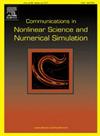Calculating SIRD model parameters and Re-susceptibility in Malaysia, Pakistan, India and United Arab Emirates
IF 3.4
2区 数学
Q1 MATHEMATICS, APPLIED
Communications in Nonlinear Science and Numerical Simulation
Pub Date : 2025-04-22
DOI:10.1016/j.cnsns.2025.108902
引用次数: 0
Abstract
During the dynamic spread of COVID-19 and the looming threat of future pandemics the essential need of precise epidemiological models are indispensable. Key to these algorithms are the estimation of core parameters a pivotal metric indicating pandemic expansion. Yet, existing algorithms often overlook crucial facets such as viral mutations risks. Addressing this gap, we propose an innovative algorithm merging the Susceptible-Infected-Recovered-Dead (SIRD) model with Re-susceptible compartment incorporated by least square method with linear regression approach that ensures the accurate parameter estimation facilitating real-time forecasting. This idea analyzed different countries full lockdown scenario. These incorporation of statistical and mathematical algorithms enhances parameters estimation, forecasting and provides insights into re-susceptibility percentage. The experiments revealed convincing results with the incorporation of statistical and mathematical algorithms enhancing parameter estimation with best R-square values of 0.9902 for country Pakistan exemplifying its vital contribution to pandemic response strategies. Our work offers a vital tool for governments, institutions and individuals grappling with pandemic responded full lockdown policy.
计算马来西亚、巴基斯坦、印度和阿拉伯联合酋长国的SIRD模式参数和再敏感性
在COVID-19的动态传播和未来大流行的迫在眉睫的威胁期间,精确的流行病学模型的基本需求是必不可少的。这些算法的关键是对核心参数的估计,这是指示大流行扩展的关键指标。然而,现有的算法往往忽略了病毒突变风险等关键方面。为了解决这一问题,我们提出了一种创新的算法,将易感-感染-恢复-死亡(SIRD)模型与最小二乘法和线性回归方法相结合的再易感区合并,以确保准确的参数估计,从而促进实时预测。这一想法分析了不同国家全面封锁的情况。这些统计和数学算法的结合增强了参数估计、预测,并提供了对再磁化率的见解。通过结合统计和数学算法,实验显示了令人信服的结果,增强了参数估计,巴基斯坦的最佳r平方值为0.9902,说明了其对大流行应对战略的重要贡献。我们的工作为应对大流行的全面封锁政策的政府、机构和个人提供了一个重要工具。
本文章由计算机程序翻译,如有差异,请以英文原文为准。
求助全文
约1分钟内获得全文
求助全文
来源期刊

Communications in Nonlinear Science and Numerical Simulation
MATHEMATICS, APPLIED-MATHEMATICS, INTERDISCIPLINARY APPLICATIONS
CiteScore
6.80
自引率
7.70%
发文量
378
审稿时长
78 days
期刊介绍:
The journal publishes original research findings on experimental observation, mathematical modeling, theoretical analysis and numerical simulation, for more accurate description, better prediction or novel application, of nonlinear phenomena in science and engineering. It offers a venue for researchers to make rapid exchange of ideas and techniques in nonlinear science and complexity.
The submission of manuscripts with cross-disciplinary approaches in nonlinear science and complexity is particularly encouraged.
Topics of interest:
Nonlinear differential or delay equations, Lie group analysis and asymptotic methods, Discontinuous systems, Fractals, Fractional calculus and dynamics, Nonlinear effects in quantum mechanics, Nonlinear stochastic processes, Experimental nonlinear science, Time-series and signal analysis, Computational methods and simulations in nonlinear science and engineering, Control of dynamical systems, Synchronization, Lyapunov analysis, High-dimensional chaos and turbulence, Chaos in Hamiltonian systems, Integrable systems and solitons, Collective behavior in many-body systems, Biological physics and networks, Nonlinear mechanical systems, Complex systems and complexity.
No length limitation for contributions is set, but only concisely written manuscripts are published. Brief papers are published on the basis of Rapid Communications. Discussions of previously published papers are welcome.
 求助内容:
求助内容: 应助结果提醒方式:
应助结果提醒方式:


